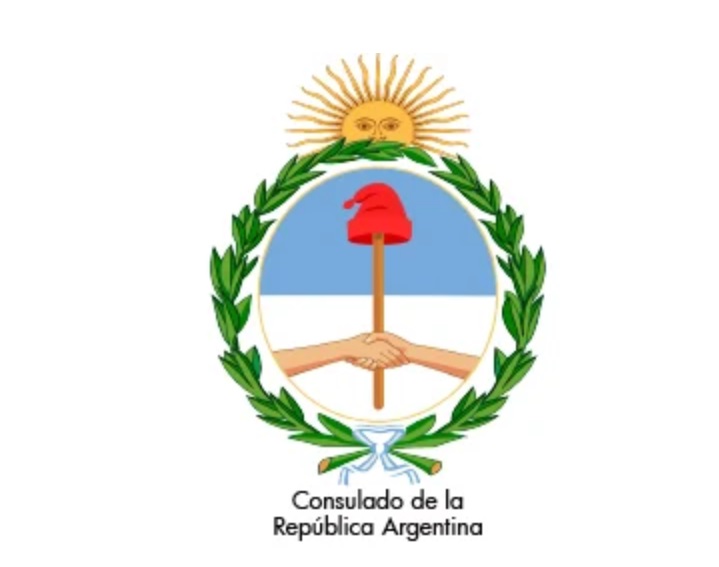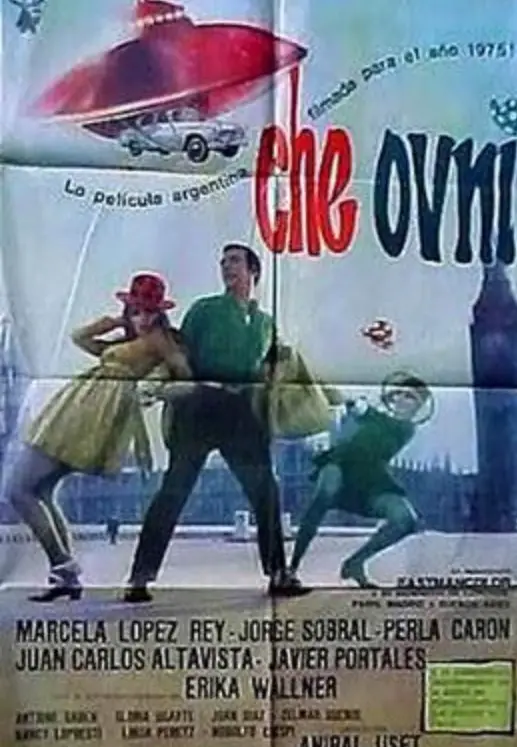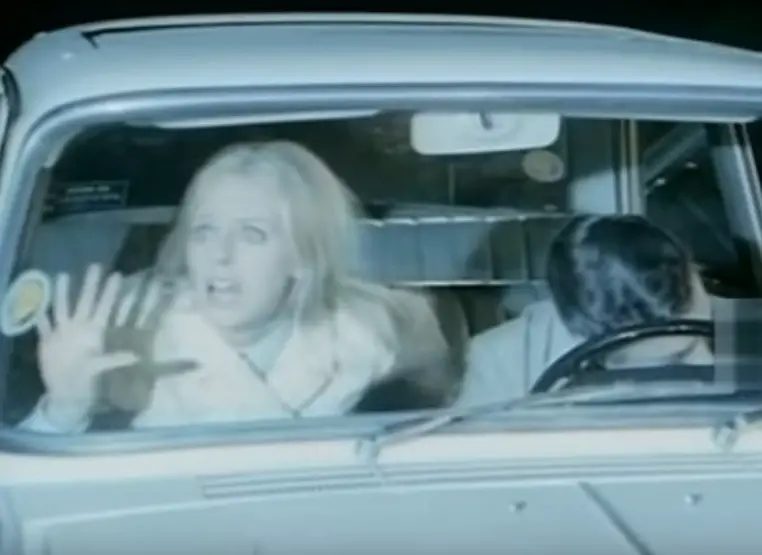 Doctor Geraldo Vidal and his wife Raffa felt dazed as they regained consciousness on the side of a rural road just outside of Mexico City. It was early May in the year 1968. The couple had not remembered pulling off the road for a short nap and when they shook off their sleep-induced disorientation, they did not know where they were. The road seemed strange and so was the terrain. There were strange mountains in the distance which looked almost like volcanoes. The countryside was green. It was warm outside, not cold as when they had left their house. The two felt unusually groggy and both had severe neck pain. Doctor Vidal got out of their Peugeot 403 and looked around. He noticed that their car was covered in burn marks, as if scorched by a blow torch. Raffa exited the car too and scanned their surroundings. Nothing looked familiar. The couple decided to get back into their car and drive until they saw someone to ask for directions. Within a few minutes they did come across people walking alongside the road. After hailing them and stopping to talk, the Vidals immediately noted their strange accent. What followed was mind-blowing. The couple found out that they were in the middle of Mexico, almost four thousand miles away from their home which they left in their little car just two days earlier. The Vidals were from Argentina and had no idea how or why they ended up on that rural road so far from home. Their first impulse was to head to Mexico City, just an hour or so away, to present themselves at the Argentinian Consulate, and see what officials from their own country could do to help them.
Doctor Geraldo Vidal and his wife Raffa felt dazed as they regained consciousness on the side of a rural road just outside of Mexico City. It was early May in the year 1968. The couple had not remembered pulling off the road for a short nap and when they shook off their sleep-induced disorientation, they did not know where they were. The road seemed strange and so was the terrain. There were strange mountains in the distance which looked almost like volcanoes. The countryside was green. It was warm outside, not cold as when they had left their house. The two felt unusually groggy and both had severe neck pain. Doctor Vidal got out of their Peugeot 403 and looked around. He noticed that their car was covered in burn marks, as if scorched by a blow torch. Raffa exited the car too and scanned their surroundings. Nothing looked familiar. The couple decided to get back into their car and drive until they saw someone to ask for directions. Within a few minutes they did come across people walking alongside the road. After hailing them and stopping to talk, the Vidals immediately noted their strange accent. What followed was mind-blowing. The couple found out that they were in the middle of Mexico, almost four thousand miles away from their home which they left in their little car just two days earlier. The Vidals were from Argentina and had no idea how or why they ended up on that rural road so far from home. Their first impulse was to head to Mexico City, just an hour or so away, to present themselves at the Argentinian Consulate, and see what officials from their own country could do to help them.
The Vidals arrived in Mexico City and went straight to their country’s consulate. While waiting to see Argentina’s consul in Mexico, a man named Rafael Lopez Pellegrini, Dr. Vidal was allowed to use the consulate’s phone. He called his friend Martin Rapallini a notary who lived in the town of Maipú, located 175 miles south of Argentina’s capital, Buenos Aires. Doctor Vidal wanted  everyone back home to know that he and his wife were fine and would be returning to Argentina soon. Señor Rapallini spread the word among friends and family members of the Vidals who had been searching for them for the past two days. Of course, no one could believe the story that Geraldo and Raffa Vidal, along with their car, had somehow ended up in central Mexico so many thousands of miles away. When the Argentine consul finally met with the Vidals, he asked the couple to relate their story to him and also asked them to promise him not to tell anyone else the details of what had happened. Before their meeting Consul Pellegrini had been briefed on the case and had made some phone calls and was instructed to take down the details of the Vidals’ story and impound their car.
everyone back home to know that he and his wife were fine and would be returning to Argentina soon. Señor Rapallini spread the word among friends and family members of the Vidals who had been searching for them for the past two days. Of course, no one could believe the story that Geraldo and Raffa Vidal, along with their car, had somehow ended up in central Mexico so many thousands of miles away. When the Argentine consul finally met with the Vidals, he asked the couple to relate their story to him and also asked them to promise him not to tell anyone else the details of what had happened. Before their meeting Consul Pellegrini had been briefed on the case and had made some phone calls and was instructed to take down the details of the Vidals’ story and impound their car.
The Vidals’ case garnered international attention a few months later when their story was written about in a British magazine called Flying Saucer Review, a quarterly publication put out by Derek Dempster, an ex-pilot for the UK’s Royal Air Force. The author of the article called “Teleportation from Chascomús to México,” was Oscar Galíndez, a famous Latin American ufologist. In the article he gives a brief description of the events of that fateful night:
“In early May 1968, a well-known Buenos Aires attorney, Dr. Geraldo Vidal, decided to attend a family get-together with his wife, Mrs. Raffa Vidal, to be held in the city of Chascomús, less than 120 km distant from Buenos Aires and to the south. They left the gathering shortly before midnight and decided to drive to Maipú, a community some 150 km south of Chascomús, as they had friends and relatives there.
“Driving along national highway No. 2, they had in front of them another car, containing another couple that also had relatives in Maipú. This other family, whose name is unknown, reached Maipú without incident, but this was not the case with the Vidals, whose delay became a cause of concern for those who awaited them. Then, the other couple decided to retrace its steps along the same route in an effort to find them but had to return to Maipú without achieving this goal or having found the slightest trace of the car or its occupants.”
At the Argentine Consulate in Mexico City, the couple would describe how their car was enveloped in a strange fog and the next thing they knew they were somewhere north of Mexico City, still sitting in their same car, the Peugeot 403. They had no recollection of the missing two days, which amounted to a total of 58 hours.
 Although the government officials asked the Vidals not to talk about their case, the word got out because there were many people involved, from eyewitnesses on the side of the road in rural Mexico to concerned relatives and friends in Argentina. The press in Mexico was silent about the incident, but several papers in the Vidals’ home country carried versions of the story. A Buenos Aires daily newspaper called La Razón published information about the case under the headline “Qué es esto?” which means in English, “What is this?”. The newspaper La Mañana reported the presence of UFOs in the area at the time of the alleged teleportation. That seemed to give a tidy and plausible explanation. UFO researchers believe that the story of the Vidal case in La Mañana caused many other people to speak out about sightings and experiences with UFOs in the region south of Buenos Aires. Others believe that the Vidal case triggered a wave of mass hysteria throughout the Argentine countryside, leading many people to see strange objects in the skies and attribute what they were seeing to extraterrestrials.
Although the government officials asked the Vidals not to talk about their case, the word got out because there were many people involved, from eyewitnesses on the side of the road in rural Mexico to concerned relatives and friends in Argentina. The press in Mexico was silent about the incident, but several papers in the Vidals’ home country carried versions of the story. A Buenos Aires daily newspaper called La Razón published information about the case under the headline “Qué es esto?” which means in English, “What is this?”. The newspaper La Mañana reported the presence of UFOs in the area at the time of the alleged teleportation. That seemed to give a tidy and plausible explanation. UFO researchers believe that the story of the Vidal case in La Mañana caused many other people to speak out about sightings and experiences with UFOs in the region south of Buenos Aires. Others believe that the Vidal case triggered a wave of mass hysteria throughout the Argentine countryside, leading many people to see strange objects in the skies and attribute what they were seeing to extraterrestrials.
The Vidals’ impounded car was sent to the United States for research and was never seen by the couple again. When they landed in Buenos Aires a new Peugeot 403 was waiting for the Vidals at the airport, and no one knew exactly who was responsible for replacing their vehicle. Señora Vidal supposedly became so overcome by the trauma of what had had happened to them that she was admitted to a mental institution within weeks of her return to Argentina. Although not confirmed, sources indicate that while still institutionalized, she died of leukemia the next year. Some researchers believe that Raffa Vidal’s rapid-onset cancer was caused by the lethal doses of radiation she was exposed to during the whole teleportation experience.
Some may wonder why did the Vidals get transported so far away and did there necessarily have to be a UFO involved? In the archives of the bizarre around the world, there are many stories of mysterious teleportations of people hundreds or even many thousands of miles from their points of origin. The Vidal case was not the first time when Mexico was the recipient of a famous teleportation. In October of 1593, Manila palace guard Gil Pérez nodded off and woke up 9,000 miles away in Mexico City. For more information about this famous case, please see Mexico Unexplained episode number 103 titled “The Teleportation of Gil Pérez” https://mexicounexplained.com/teleportation-gil-perez/ Some believe that “the veil is thin” in some parts of Mexico and wormholes or tears in space-time may account for mysterious teleportation events.
Others believe that since the United States was so quick to be involved – even taking away the Vidals’ vehicle – that somehow the Argentine couple got caught up in some top-secret, high-tech government experiment sponsored by an American alphabet agency. Allegations of NASA or CIA involvement quickly circulated. The heavy hand of the United States may have been responsible for a complete news blackout of the event within weeks of its happening. News outlets in both Mexico and Argentina, from TV to radio to print, abruptly stopped covering the Vidal case even though the public still showed intense interested in it. Was this an example of spontaneous teleportation, alien abduction, or an American black op? There were many open questions here that begged to be answered.
With much time passed, in the late 1980s and early 1990s researchers began revisiting this mysterious teleportation case. In the fall 1994 issue of the paranormal journal Magonia, UFO researcher Peter Rogerson explained the Vidal case in an article titled, “Notes to a Revisionist History of Abduction, Part 4: Recovering the Forgotten Records.” In the publication Rogerson claimed to have gone to Buenos Aires to try to track down the Vidals, and came to the conclusion that the whole story was fabricated to cover up Señora Vidal’s mental breakdown and subsequent institutionalization. Those who ran with this story claimed that at the time the article was written – 1994 – the poor woman was still locked away in an unknown Argentine mental facility and her death of leukemia was reported to stop all investigations into her real whereabouts.
 Two years later, in 1996, the Vidal teleportation case took an unexpected turn. That year Argentinian researcher and journalist Alejandro Agostinelli tried tracking down the major players in the event. He could find people who claimed they knew the teleportees but he could not find the Vidals themselves or anyone else mentioned in the original accounts. Agostinelli interviewed a filmmaker named Anibal Uset and together with Luis González published a paper about the Vidal incident titled “Coches Voladores a Estrenar: Fraudes, Rumores y Ciencia Ficción” which translates in English to “Brand New Flying Cars: Frauds, Rumors and Science Fiction.” The article was published in Spain in a work titled Anuario, Cuadernos de Ufología, which means “Yearbook, UFOlogy Notebooks” in English. In the article the authors explore how the whole Vidal story was faked in order to promote a movie directed by Anibal Uset called “Ché OVNI,” which was released on August 7, 1968, some three months after the Vidal incident supposedly took place. Uset claimed he started the story of the Vidal teleportation to drum up interest in his film, which was ultimately panned and derided when it hit the theaters in Argentina. The film at the time of this recording is available for free on YouTube. The movie opens with a woman – played by 1960s Argentine blonde bombshell Erika Wallner – driving a Peugeot 403 on a lonely road south of Buenos Aires at night. She picks up a hitchhiking tango singer played by Jorge Sobral. A few more minutes into the movie, a bright light appears, the blonde woman exits the car as the man passes out, and then a cheesy-looking flying saucer lifts the car off the road. The film then cuts to a scene when it’s daylight. The man is now driving the car and notices a road sign for Madrid. There is another woman in the car, who is not the original blonde woman. A police officer stops the car, asks for the man’s drivers license and tells him he is not legally allowed to be driving in Spain. So, instead of a Peugeot 403 being transported magically to the middle of Mexico, in the movie it is sent to the middle of Spain. In the interview, the film’s director, Anibal Uset, even admitted that his personal assistant, a man named Juan Alberto Mateyko, appeared on an Argentine talk show a month before the film’s release as a phony witness in the Vidal teleportation case.
Two years later, in 1996, the Vidal teleportation case took an unexpected turn. That year Argentinian researcher and journalist Alejandro Agostinelli tried tracking down the major players in the event. He could find people who claimed they knew the teleportees but he could not find the Vidals themselves or anyone else mentioned in the original accounts. Agostinelli interviewed a filmmaker named Anibal Uset and together with Luis González published a paper about the Vidal incident titled “Coches Voladores a Estrenar: Fraudes, Rumores y Ciencia Ficción” which translates in English to “Brand New Flying Cars: Frauds, Rumors and Science Fiction.” The article was published in Spain in a work titled Anuario, Cuadernos de Ufología, which means “Yearbook, UFOlogy Notebooks” in English. In the article the authors explore how the whole Vidal story was faked in order to promote a movie directed by Anibal Uset called “Ché OVNI,” which was released on August 7, 1968, some three months after the Vidal incident supposedly took place. Uset claimed he started the story of the Vidal teleportation to drum up interest in his film, which was ultimately panned and derided when it hit the theaters in Argentina. The film at the time of this recording is available for free on YouTube. The movie opens with a woman – played by 1960s Argentine blonde bombshell Erika Wallner – driving a Peugeot 403 on a lonely road south of Buenos Aires at night. She picks up a hitchhiking tango singer played by Jorge Sobral. A few more minutes into the movie, a bright light appears, the blonde woman exits the car as the man passes out, and then a cheesy-looking flying saucer lifts the car off the road. The film then cuts to a scene when it’s daylight. The man is now driving the car and notices a road sign for Madrid. There is another woman in the car, who is not the original blonde woman. A police officer stops the car, asks for the man’s drivers license and tells him he is not legally allowed to be driving in Spain. So, instead of a Peugeot 403 being transported magically to the middle of Mexico, in the movie it is sent to the middle of Spain. In the interview, the film’s director, Anibal Uset, even admitted that his personal assistant, a man named Juan Alberto Mateyko, appeared on an Argentine talk show a month before the film’s release as a phony witness in the Vidal teleportation case.
 Some other researchers see flaws in the story that Uset created an elaborate urban legend just to promote a really bad science fiction movie. The director said this in a subsequent interview about his film and the Vidal case:
Some other researchers see flaws in the story that Uset created an elaborate urban legend just to promote a really bad science fiction movie. The director said this in a subsequent interview about his film and the Vidal case:
“So many people approached me to say that they had known the Vidals that I began to have doubts. What is more, the confusion was such that I began to think that our story coincided with something that had really happened.”
Why would the director say such a thing if he was behind the supposed hoax from the very beginning? The counter argument is that the scenes in the movie featuring the teleportation in the Peugeot were inserted into the film immediately after the Vidal event, and the hoax story is itself a hoax to cover up some serious shenanigans by government agencies or to hide the truth of a real alien abduction. Unfortunately, the whole truth may never be known here.
REFERENCES
Anuario, Cuadernos de Ufología,(in Spanish)
Flying Saucer Review
Inexplicata, the Hispanic UFO Site
